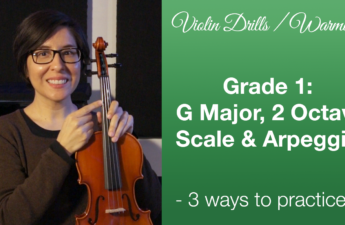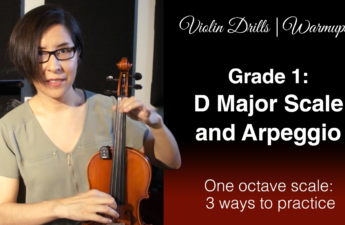As a prerequisite, I recommend you learn and practice the A and D major one octave scales AND, most importantly, the G major two octave scale. If you have not yet learned how to do those scales yet, you can do so by
checking out my previous vlogs that covers those scales in detail within my past posts on this blog site.
The C Major one octave scale has a slightly different finger pattern than the previous beginner scales. It’s a very useful scale for practicing your natural second finger notes where the second finger needs to land next to the first finger. As opposed to the sharps that typically land a whole step down from the first finger.
Lets go over the C major one octave scale in detail:
- This time you will start off with your third finger on the G string to hit your first C natural note. You do this by putting all three fingers down on the G string in the G major scale pattern. (This is why it’s helpful to learn the G major scale first, that way you will not have too much trouble finding that C)
- Use your fourth finger to hit D, you do this by going down a whole step from your third finger
- First finger on the D string will land on E
- Second finger will do a half step down from your first finger to hit F Natural
- Third finger will go whole step down to hit G
- Fourth finger will go a whole step down to hit A
- Slip your first finger from the D string to the A string to hit B
- And last, your second finger will do a half step to hit your last C Natural note
In the video below, I demonstrate two different ways to practice this scale, both using all four fingers. You can choose to practice with open strings if you want, but I figure by this time you should always be exercising your fourth finger so that it can gain as much strength as possible.
I will begin with slow steady single bow strokes that will be accompanied by a piano reference track, then I will implement slurs – in this case I will play two notes per bow stroke and I will do this without any backup – I will just listen closely at my intonation.
For the C Major Arpeggio:
- Start with your 3rd finger on G (to hit C),
- First finger on D hits E,
- Third finger on D to hits G,
- And finally 2nd finger will hit C natural on the A String.
This scale along with the G major two octave scale is very useful in practicing and getting used to hitting the natural second finger notes.
*A quick tip – especially when you’re going backwards is to always place the first finger down as a guide for the second finger to land as accurate as possible.
So there you have it, the C major one octave scale and arpeggio. This concludes my grade 1 beginner violin scales. I hope this helps you out in your violin journey.
If you’re interested in the reference track I used to play the C Major scale, please visit my Patreon page to download the MP3 file.


